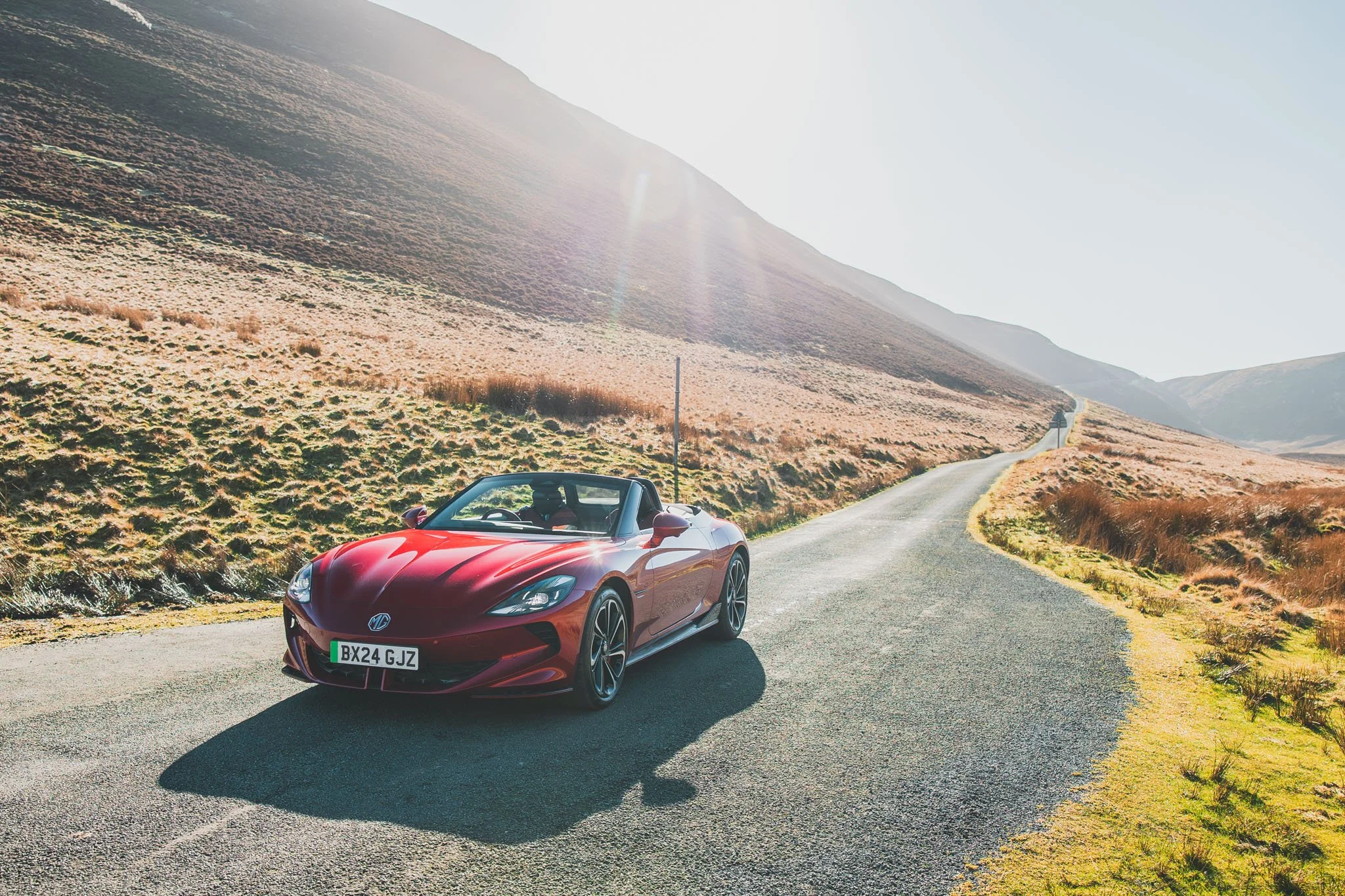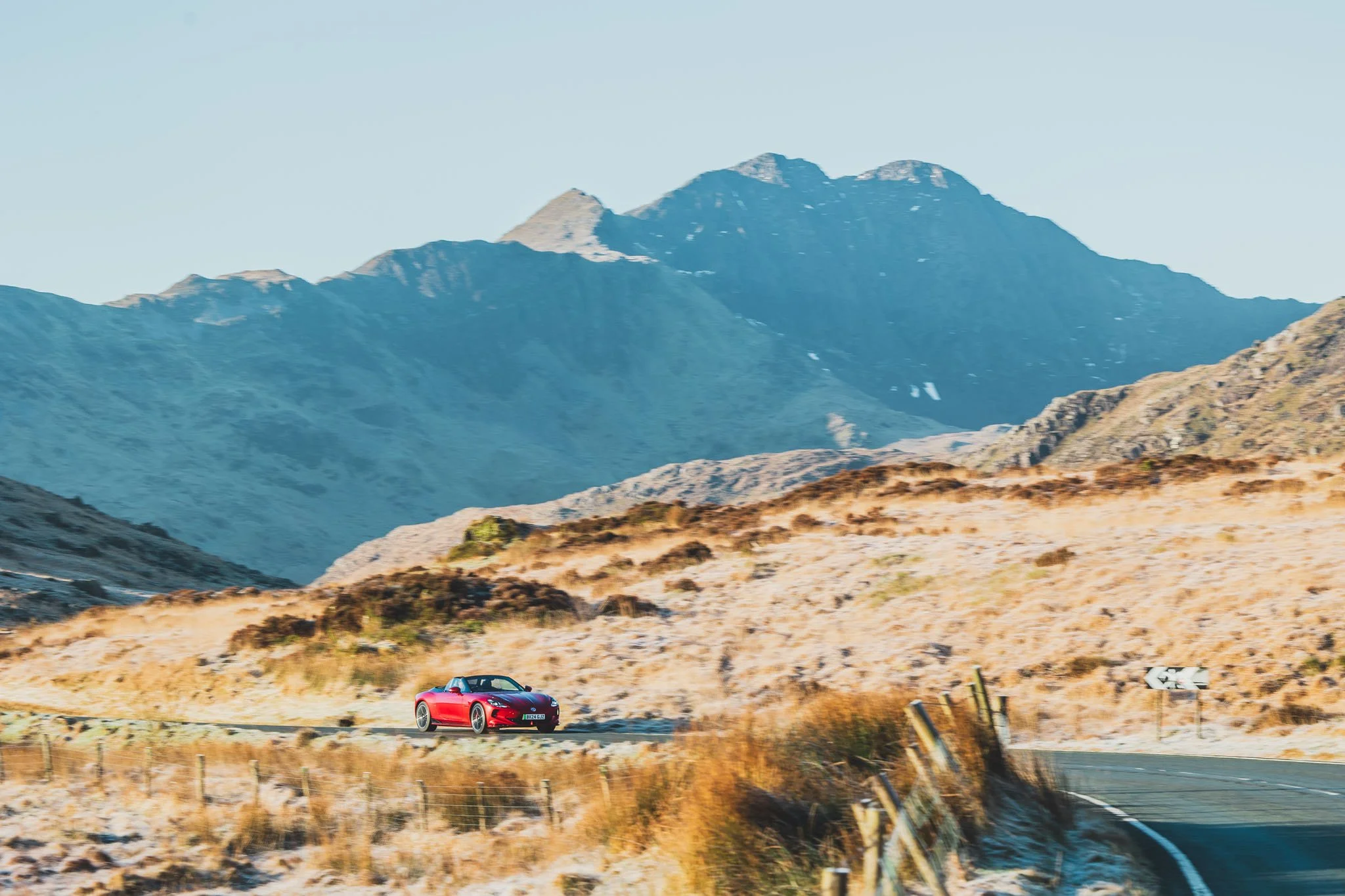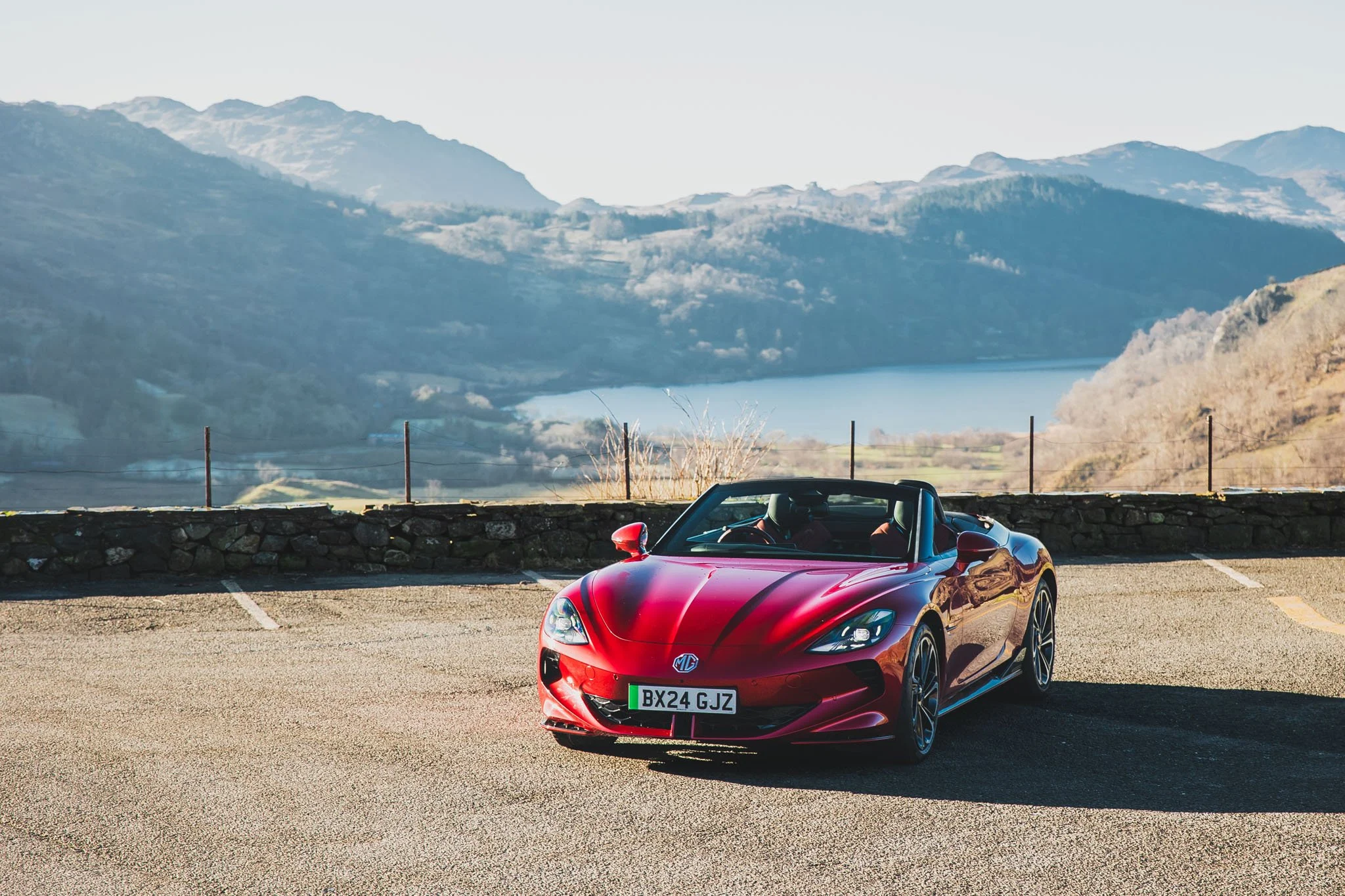MG Cyberster GT - One of a Kind
For the past week, I've been driving the new sports car statement piece from MG. It is a fully electric sports car that has been designed to be noticed. This particular model is the 503 hp 'GT' variant, making it a proper little pocket rocket. It wouldn't be my first time in the model, but it would be an opportunity to experience the car for more than a few hours and on a proper adventure.
What is the Cyberster?
The Cyberster is a 100% electric two-seat convertible sports car. On the outside, it is visually stunning from every angle; on the inside, it's equally pleasant to the eye. Aside from the slightly oversized badges on the bonnet and boot lid, there is absolutely nothing I would change about its design - it's an achingly pretty car.
Beyond the positive visual first impressions comes some added drama from the doors. MG has decided that for its new flagship sports car, conventional outward-opening doors simply won't do and instead has opted for motorised scissor doors that open upwards - a real spectacle. Once in the driver's seat, you're met with no less than four display screens ahead of you. To the left and on the lower section of the centre console is a touch screen that allows for adjustments to climate control and driving modes. Above that and to the left of the steering wheel is a screen for infotainment, which houses either the built-in navigation system or the interface for Apple Car Play and Android Auto. Directly behind the steering wheel is a screen showing, as you might expect, speed, power, range and charge levels. Finally, to the right of the steering wheel is the 4th screen, which controls more intricate settings and displays charging information. The interior quality of the Cyberster is superb. The attention to detail inside the car is worthy of very high praise.
Trophy vs GT
There are two variants of Cyberster on offer: Trophy and GT. The GT is the most powerful option, with 503 hp delivered to all four wheels.
The Cyberster is fully electric and, depending on which version you buy, rewards slightly different power and overall range. Both variants have a 77kWh battery; however, the single motor (RWD) Trophy offers 340 hp and a claimed combined WLTP range of 316 miles, whereas the 4-wheel drive GT claims a combined WLTP of 276 miles. The weight difference is the other factor to note between the two models, with the single motor Trophy weighing 1885 kg and the faster GT adding 100 kilos thanks to the extra motor to 1985 kg.
Prices for the two models are close, with the Trophy retailing at £54,995 and the GT at £59,995 (both prices before optional extras).
The Grand Tour Test
Once I'd taken delivery from the MG press office, I decided the GT was worthy of a road trip. In the hope of finding some dramatic landscapes to photograph the car, I collected our in-house photographer, Henry Faulkner-Smith, and set out toward Snowdonia National Park in Wales with all 249 litres of boot space consumed by camera gear and a couple of overnight bags.
Given that Snowdonia isn't yet renowned for its EV charging infrastructure, I set off with the knowledge that there may be some logistical constraints to the trip. I did so, however, knowing that the Cyberster is a GT car and is likely to be purchased by people who want to embark on an occasional adventure. Departing Warwickshire and heading toward Wales, I set my first destination as a fast charger in the border town of Welshpool.
Most of the journey into Wales from Warwickshire consists of motorways and dual carriageways. With the roof up, noise levels from wind and other traffic are as good as you'd find in a luxurious convertible supercar priced at twice that of the MG. The driving position feels good, the seating position is comfortable, and all in all, the Cyberster accomplishes long-distance driving with ease thanks to added luxuries such as heated seats, a heated steering wheel and a Bose sound system to keep you entertained.
We arrived in Welshpool with a 4% remaining charge and an indicated range of zero miles on the instrument cluster. Ideal for the perfect first test: charging times.
The Reality of EV Range in Winter Driving
The 100% charge at Welshpool with a 150kW fast charger took 1 hour and 45 minutes, resulting in a rewarded range of 182 miles - almost 100 miles short of MG's claimed best-case scenario. With only 80 miles to the planned overnight destination of Caerfanon on the North West coast of Wales, this should have been more than achievable; however, as the afternoon panned out, I was reminded of the less appealing side to long-distance EV driving - especially in a chilly mid-winter.
The purpose of my trip with photographer Henry was to get some stunning photographs of the car, so naturally, the idea of getting to our destination isn't quite as straightforward as a typical a-to-b drive. Photographing cars requires multiple passes on scenic roads and repeated journeys on certain routes to find the most idyllic spot for the right shot.
By the time we had obtained our first collection of photographs around the two picturesque lakes of Vwerny and Bala, the Cyberster was already down to its last 100 miles of range, and we hadn't yet made it to the scenic spots of Snowdonia. We needn't have worried, though, as the sun had set and we had lost the light, so the priority switched from the creative stuff to getting to Caerfanon for a rest and a recharge. On the day's final drive, I discovered two additional setbacks to the Cyberster's remaining range: The A5 road and my own right foot.
Enjoying the fast roads
The A5 is a stunning road that cuts through North Wales, eventually joining the A55 dual carriageway in the North towards Holyhead. It's a mostly 60mph road with some outrageously beautiful views on either side. The route passes through quaint villages between mountainous valleys and alongside idyllic lakes that look dramatically black in the setting sunlight. The A5 climbs and dips in conjunction with the surrounding mountains, and with the roof down, heaters on and a cinematic soundtrack to accompany us through the Bose speakers, I was lost in the exciting flow of accelerating along straights and cutting corners for the most rewarding driving lines.
At one point, I looked at Henry in the passenger seat and exclaimed that I was having 'a very good time'. 'I can tell!' - he shouted back. The Cyberster doesn't just look like a sports car; on the right section of road, it genuinely feels like one, too.
On flatter road sections, I could have been convinced that I was driving a lightweight Porsche Boxster or BMW Z4. The fact that its electricity propelling the Cyberster rather than six cylinders of petrol power is apparent only through brutal acceleration and silent whooshes. With the roof down, the atmosphere is a buzz of excitement. The Cyberster turns into corners and scrubs speed reassuringly, either through the regenerative braking or with a firm press of the left pedal. However, through more significant undulations or fast sweeping corners, the lightweight illusion is quickly quashed, and you're reminded very abruptly of the car's mass, which results in quick adjustments (read as: less ambitious) entry speeds into following corners.
The Cyberster doesn't quite have the spritely lightweight agility of a 1,300 kg Boxster or even a 1500 kg Z4. However, providing you know what to expect, the Cyberster can reward a truly exhilarating drive.
The Downside of EV Sports Cars
As with all the fun stuff in life, what goes up most often must come back down again with a bump. As I was nearing the end of the scenic A5, the 180 miles of range I'd departed Welshpool with had been consumed at an alarming rate, leaving me with just 50 miles of remaining power. Whilst I had plenty of range to complete my drive, it would have been a killer if I'd wanted to repeat one or two of the fun roads or take a spontaneous detour elsewhere. There comes a time in EVs when you, as the driver, must prioritise the next charge before the next instalment of fun stuff - and that can be somewhat of a buzzkill.
We made it to our overnight rest stop and an EV charge point in the town of Caefornon. Our plan for the following day was an early start for a frosty photographic sunrise. It was the frosty aspect of the morning after, though, that would present another unexpected challenge for our Cyberster.
Cool Doors (with Flaws)
Beyond the car's good looks, the Cyberster's doors are the car's party trick. Pressing buttons on the key fob opens both doors remotely as you walk towards the car. As is the norm in convertibles, the windows drop slightly, and then the doors rotate out and upward. At their final resting point, the two doors in the open position look like two celebratory arms outstretched in the air, and the spectacle turns heads in every environment.
On an icy morning in North West Wales, though - the drama was somewhat diluted as, with a press of the button, the driver's door wouldn't budge. The cause was ice. The top of the window had frozen in contact with the rubber seal, which cancelled the ability to drop and allow the opening process to commence. Following a short sequence of faff, expletives and some nervous laughter in reaction to some very alarming mechanical sounds, eventually, we were in.
In fairness to the car - this is a very specific circumstance which would likely be a pain in any convertible sports car, but there is no denying that the mechanics of the doors didn't help. If we were opening the car in mid-summer or even a marginally milder springtime, I wouldn't have thought twice about the process... but there was one further flaw to discover, which would be apparent in all seasons regardless of ambient temperature.
The other substantial flaw to the doors made itself known when the car was parked on a surface that was anything other than completely flat. The motors within the doors clearly have a resistance sensor, and if they deem the movement to be strenuous, the opening process will stop mid-flow. This resistance was apparent when the car was parked on a hill and at times when the ground wasn't completely flat. The result of the car's sensors declining the movement is the requirement to either manually push the doors up and outwards from the inside or pull the door up manually from the base when standing on the outside. Sensors on the door also detect potential contact points that cause the doors to stop opening. This is potentially helpful if an adjacent car has parked inconveniently close but more often is annoying when it detects your leg standing near the car, requiring you to restart the process.
Personally, if given the option of a dramatic motorised scissor door or a good old-fashioned manual door with a mechanical handle - I'll opt for the traditional method every time. Sure, the doors look great - but for me, they proved to be more of a faff than a feature.
The inconvenience of EV sports Cars (Part 2)
On paper, electric sports cars make a lot of sense. With a fast charger, the battery on the Cyberster GT can charge from 20-80% in 38 minutes, granting a best-case scenario of around 170 miles of range. Then, once charged, you, as a driver, have access to physics-defying acceleration speeds. The GT accelerates from 0-62 in just 3.2 seconds. That's supercar quick, and the handling - despite the hefty 2-tonne payload - is dynamic enough to convince the average Joe that they're driving something genuinely exciting.
With an almost full battery, I was excited about a morning of mountainous fun followed by a sedate drive back home to Warwickshire. The fun stuff was indeed fun, and I had a superb drive through the mountains for photos and videos and to enjoy some of Wales' most breathtaking scenery - but it was, as to be expected, only fun up to a point. The point for me was the realisation that I'd once again churned through 100 miles of predicted range by covering less than half of my allowance on fast roads with steep hills and a less-than-helpful ambient temperature of 2 degrees C. If I were driving on the outskirts of a big city or even remotely close to a motorway service station, I'd have considered a quick detour and a twenty-minute stop to recharge. However, on the A4068 in the shadows of Mount Snowdon, neither a city centre nor a motorway service station is an option.
The result of the realisation is the necessity to drive as sedately as possible to achieve the required mileage to get to a fast charger. To call it a mood killer is a bit of an understatement - this requirement to charge and plan routes between charges removes all spontaneity from the sort of adventurous driving I'd set out to enjoy in a fun GT car.
This scenario will be a significant factor in turning people off the idea of an EV sports car for a few years to come. It's not the fault of MG or any other manufacturer - this is an infrastructure issue that is probably towards the very bottom of the list of local authorities' priorities.
Making the most of the ordinary
Once we had concluded our photography in the mountains, we ventured back towards Welshpool for another full charge. At more sedate speeds, I could take in some of the many other positives of the Cyberster, such as the Bose sound system, adaptive cruise control and general ease of driving. The Cyberster also has the option of regenerative braking and even one-pedal driving, which maximises potential battery recharge through kinetic energy. As a driver, I find Cyberster to be not only easy and pleasant to drive but also a charming place. When stopping at traffic lights or scenic points for some last-minute photos, Henry and I were greeted with smiles and questions from admirers wanting to know more about the car and share stories of MG's from their own family history.
But… Who is it for?
Anyone looking for an EV that's likely to turn heads and be one of a kind in either the workplace or supermarket car park, the Cyberster will take some beating. But the more I think about the potential buyer of the Cyberster, the more I get confused by who's actually likely to part with their cash for one.
Possibly too Powerful
At 503 hp, the Cyberster GT has approximately twice the power it needs. Even 200 hp would be ample and would probably return more range, too - reducing the requirement to prioritise route planning over spontaneity.
The £60k price point certainly works in its favour, and for buyers insistent on wanting an EV convertible sports car, again, it will be tricky to place a competitor against the Cyberster until Porsche releases its electric Boxster - but even Porsche has admitted that it's struggling with both development and predicted sales of the model due to the demise in customer demand for existing EV models.
One-of-a-kind?
MG has admitted that the Cyberster is not a model that the brand expects to sell vast numbers of. MG continues under Chinese ownership as the maker of affordable everyday cars, with the occasional statement-piece sports model. The Cyberster is precisely that; it's the modern-day sports car statement as seen previously in the form of the MG A in the 50s, the MG RV8 in the 90s and the MG F of the new millennium.
Quirks and all, it's impossible to dislike the Cyberster for what it is - (daft doors and all!), but I have to admit, I struggle to imagine seeing many on our roads in place of larger and more conventional performance EVs.
Just like the vast majority of sports cars and supercars, the Cyberster is a wonderfully unnecessary thing. Nobody on this planet needs a 500-hp electric convertible sports car, yet a bold few will no doubt bite the bullet, and I will smile in admiration toward every single person who does.
words by John Marcar
photography by Henry Faulkner-Smith































